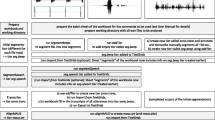Abstract
Variation of amplitude envelope at stimulus onset has been considered to be of primary importance for distinguishing voiceless affricates from fricatives (e.g., |t∫| and |∫|). In earlier perceptual experiments, however, variation in amplitude rise time was confounded with variation in frication duration. In two experiments, these variables were independently manipulated, and their individual and combined effects for perception of |t∫| and |∫| were examined. Variation in amplitude rise time alone was not sufficient to signal the voiceless affricate/fricative contrast in these experiments, but variation in frication duration alone was sufficient.
Similar content being viewed by others
References
Cutting, J. E., &Rosner, B. S. (1974). Categories and boundaries in speech and music.Perception & Psychophysics,16, 564–570.
Diehl, R. L., &Walsh, M. A. (1986). An auditory basis for rate normalization in stops and glides.Journal of the Acoustical Society of America,80(Suppl. 1), S125.
Diehl, R. L., &Walsh, M. A. (1989). An auditory basis for the stimulus-length effect in the perception of stops and glides.Journal of the Acoustical Society of America,85, 2154–2164.
Dorman, M. F., Hannley, M. T., McCandless, G. A., &Smith, L. M. (1988). Auditory/phonetic categorization with the Symbion multichannel cochlear implant.Journal of the Acoustical Society of America,84, 501–510.
Dorman, M. F., Marton, K., &Hannley, M. T. (1985). Phonetic identification by elderly normal and hearing-impaired listeners.Journal of the Acoustical Society of America,77, 664–670.
Dorman, M. F., Raphael, L. J., &Isen Berg, D. (1980). Acoustic cues for the fricative-affricate contrast in word-final position.Journal of Phonetics,8, 397–405.
Dorman, M. F., Raphael, L. J., &Liberman, A. M. (1979). Some experiments on the sound of silence in phonetic perception.Journal of the Acoustical Society of America,65, 1518–1532.
Gerstman, L. J. (1957).Perceptual dimensions for the friction portions of certain speech sounds. Unpublished doctoral dissertation, New York University.
Howell, P., &Rosen, S. (1983). Production and perception of rise time in the voiceless affricate/fricative distinction.Journal of the Acoustical Society of America,73, 976–984.
Jones, D. (1956).An outline of English phonetics (8th ed.). Cambridge, U.K.: W. Herrer & Sons.
Kluender, K. R., &Walsh, M. A. (1988). Effect of vowel duration on the perception of syllable-initial |∫| and |t∫|.Journal of the Acoustical Society of America,84(Suppl. 1), S158.
Mack, M., &Blumstein, S. (1983). Further evidence of acoustic invariance in speech production: The stop-glide contrast.Journal of the Acoustical Society of America,73, 1739–1750.
Miller, J. L., &Liberman, A. M. (1979). Some effects of later-occurring information on the perception of stop consonant and semivowel.Perception & Psychophysics,25, 457–465.
Nartey, J. N. A. (1982).On fricative phones and phonemes: Measuring the phonetic differences within and between languages (UCLA Working Papers in Phonetics, No. 55).Los Angeles: University of California.
Nittrouer, S., &Studdert-Kennedy, M. (1986). The stop-glide distinction: Acoustic analysis and perceptual effect of variation in syllable amplitude envelope for initial |b| and |w|.Journal of the Acoustical Society of America,80, 1026–1029.
Shinn, P. C., &Blumstein, S. E. (1984). On the role of the amplitude envelope for the perception of [b] and [w]: Further support for a theory of acoustic invariance.Journal of the Acoustical Society of America,75, 1243–1252.
van Heuven, V. J. (1979). The relative contribution of rise time, steady time, and overall duration of noise bursts to the affricate-fricative distinction in English. In J. J. Wolf & D. H. Klatt (Eds),ASA*50 speech communication papers (pp. 307–311). New York: Acoustical Society of America.
Walsh, M. A., &Diehl, R. L. (1991). Formant transition and amplitude rise time as cues to the stop/glide distinction.Quarterly Journal of Experimental Psychology,43A, 603–620.
Walsh, M. A., Kluender, K. R., &Diehl, R. L. (1988). Frication duration and amplitude rise time as cues to the voiceless fricative/affricate distinction.Journal of the Acoustical Society of America,84 (Suppl. 1), S156.
Author information
Authors and Affiliations
Corresponding author
Rights and permissions
About this article
Cite this article
Kluender, K.R., Walsh, M.A. Amplitude rise time and the perception of the voiceless affricate/fricative distinction. Perception & Psychophysics 51, 328–333 (1992). https://doi.org/10.3758/BF03211626
Received:
Accepted:
Published:
Issue Date:
DOI: https://doi.org/10.3758/BF03211626




